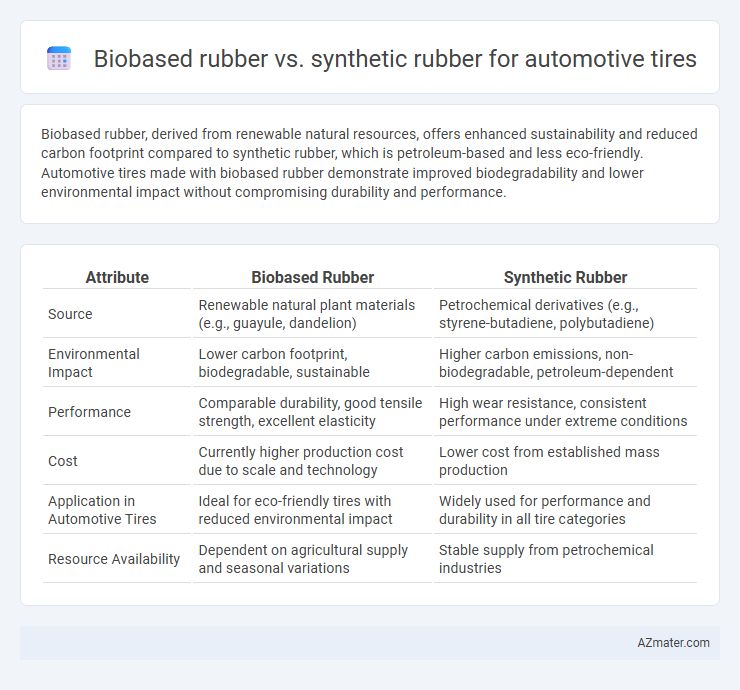Biobased rubber, derived from renewable natural resources, offers enhanced sustainability and reduced carbon footprint compared to synthetic rubber, which is petroleum-based and less eco-friendly. Automotive tires made with biobased rubber demonstrate improved biodegradability and lower environmental impact without compromising durability and performance.
Table of Comparison
| Attribute | Biobased Rubber | Synthetic Rubber |
|---|---|---|
| Source | Renewable natural plant materials (e.g., guayule, dandelion) | Petrochemical derivatives (e.g., styrene-butadiene, polybutadiene) |
| Environmental Impact | Lower carbon footprint, biodegradable, sustainable | Higher carbon emissions, non-biodegradable, petroleum-dependent |
| Performance | Comparable durability, good tensile strength, excellent elasticity | High wear resistance, consistent performance under extreme conditions |
| Cost | Currently higher production cost due to scale and technology | Lower cost from established mass production |
| Application in Automotive Tires | Ideal for eco-friendly tires with reduced environmental impact | Widely used for performance and durability in all tire categories |
| Resource Availability | Dependent on agricultural supply and seasonal variations | Stable supply from petrochemical industries |
Introduction to Biobased and Synthetic Rubber
Biobased rubber, derived from renewable plant sources such as guayule and dandelion, provides a sustainable alternative to conventional synthetic rubber used in automotive tires. Synthetic rubber, primarily produced from petrochemical feedstocks like styrene and butadiene, offers consistent performance and durability critical for tire applications. Innovations in biobased rubber aim to match the tensile strength, abrasion resistance, and elasticity of synthetic rubber while reducing environmental impact in automotive manufacturing.
Key Differences in Composition and Sources
Biobased rubber for automotive tires primarily derives from natural sources such as Hevea brasiliensis latex and guayule plants, containing high levels of cis-1,4-polyisoprene, which contributes to its elasticity and biodegradability. Synthetic rubber, typically made from petroleum-based monomers like styrene and butadiene, offers enhanced uniformity and resistance to heat and wear due to its engineered polymer structures. The key compositional difference lies in the renewable, organic origin of biobased rubber versus the fossil fuel-derived, chemically synthesized nature of synthetic rubber, impacting sustainability and performance characteristics in tire applications.
Environmental Impact Assessment
Biobased rubber significantly reduces carbon emissions and reliance on fossil fuels compared to synthetic rubber, which is derived from petroleum byproducts. The cultivation of natural rubber plants supports carbon sequestration and enhances soil health, although it demands substantial land and water resources. Synthetic rubber production involves higher energy consumption and releases more toxic pollutants, contributing to greater environmental pollution and landfill waste.
Performance and Durability Comparison
Biobased rubber for automotive tires offers improved sustainability with comparable tensile strength and abrasion resistance to synthetic rubber, enhancing eco-friendly performance without compromising durability. Synthetic rubber excels in high-temperature resistance and consistent performance under varying road conditions, making it ideal for demanding tire applications. Both materials demonstrate strong wear resistance, but synthetic rubber generally provides superior longevity under extreme mechanical stresses, while biobased alternatives continue to close this durability gap through advanced formulation technologies.
Cost Analysis and Economic Feasibility
Biobased rubber, derived from renewable resources like natural latex, often exhibits higher initial production costs compared to synthetic rubber, which is mass-produced from petroleum derivatives with established manufacturing efficiency. Economic feasibility favors synthetic rubber for automotive tires due to its consistent quality, lower raw material expenses, and well-optimized supply chains, though biobased rubber benefits from growing consumer demand for sustainable alternatives and potential cost reductions through technological advancements. Long-term cost analysis must consider fluctuating oil prices, government incentives for eco-friendly materials, and evolving environmental regulations impacting the competitiveness of both rubber types.
Manufacturing Processes and Scalability
Biobased rubber for automotive tires leverages natural polymers such as guayule and dandelion rubber, utilizing eco-friendly extraction and compounding methods that reduce carbon footprint and reliance on petrochemicals. Synthetic rubber, primarily derived from petroleum-based monomers like styrene-butadiene and butadiene, is produced through well-established polymerization processes that offer high consistency and control, enabling mass production scalability. Manufacturing scalability of biobased rubber faces challenges in feedstock variability and lower yield, whereas synthetic rubber benefits from extensive existing infrastructure, ensuring faster scale-up and supply chain stability for large-scale tire production.
Regulatory Standards and Industry Trends
Biobased rubber for automotive tires is gaining traction due to stringent regulatory standards aimed at reducing carbon footprints and enhancing sustainability in the automotive sector. Synthetic rubber, primarily derived from petroleum, faces increasing regulatory pressure to meet emissions and environmental compliance, driving the industry towards greener alternatives. Current industry trends highlight a shift towards biobased materials driven by legislation such as the European Union's Green Deal and the U.S. EPA's sustainability guidelines, promoting the adoption of renewable resources without compromising tire performance.
Adoption in the Automotive Tire Industry
Automotive tire manufacturers are increasingly adopting biobased rubber due to its renewable sourcing and reduced environmental impact compared to traditional synthetic rubber derived from petrochemicals. Major industry players are investing in research to enhance the performance characteristics of biobased rubber, aiming to meet stringent safety and durability standards while achieving sustainability goals. Market trends indicate a gradual shift towards biobased rubber in tire production, driven by regulatory pressures and consumer demand for eco-friendly automotive products.
Challenges and Future Prospects
Biobased rubber faces challenges in scalability, consistent quality, and performance under extreme conditions compared to synthetic rubber, which offers superior durability and uniformity for automotive tires. Research prioritizes improving biopolymer yield, enhancing mechanical properties through genetic engineering, and integrating sustainable processing technologies. Future prospects include hybrid composites blending biobased and synthetic materials to achieve eco-friendly tires that meet safety and performance standards.
Conclusion: Choosing the Right Rubber for Tires
Selecting the appropriate rubber for automotive tires depends on performance, sustainability, and cost factors. Biobased rubber offers improved environmental benefits through renewable resources and reduced carbon footprint while maintaining competitive durability. Synthetic rubber excels in consistency, high performance under diverse conditions, and cost efficiency, making it suitable for high-demand applications.

Infographic: Biobased rubber vs Synthetic rubber for Automotive tire
 azmater.com
azmater.com